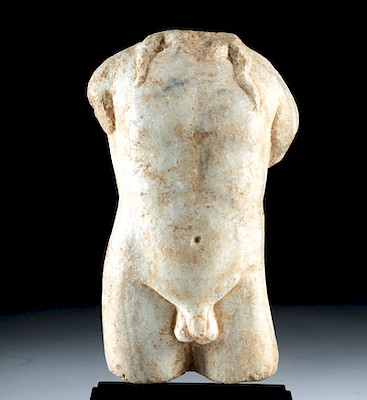Huge Corinthian Pottery Amphora - Animal Frieze w/ TL
Lot 22
About Seller
Artemis Fine Arts
686 S Taylor Ave, Ste 106
Louisville, CO 80027
United States
Selling antiquities, ancient and ethnographic art online since 1993, Artemis Gallery specializes in Classical Antiquities (Egyptian, Greek, Roman, Near Eastern), Asian, Pre-Columbian, African / Tribal / Oceanographic art. Our extensive inventory includes pottery, stone, metal, wood, glass and textil...Read more
Estimate:
$8,000 - $12,000
Absentee vs Live bid
Two ways to bid:
- Leave a max absentee bid and the platform will bid on your behalf up to your maximum bid during the live auction.
- Bid live during the auction and your bids will be submitted real-time to the auctioneer.
Bid Increments
| Price | Bid Increment |
|---|---|
| $0 | $25 |
| $300 | $50 |
| $1,000 | $100 |
| $2,000 | $250 |
| $5,000 | $500 |
| $10,000 | $1,000 |
| $20,000 | $2,500 |
| $50,000 | $5,000 |
| $100,000 | $10,000 |
| $200,000 | $20,000 |
About Auction
By Artemis Fine Arts
Dec 5, 2018
Set Reminder
2018-12-05 10:00:00
2018-12-05 10:00:00
America/New_York
Bidsquare
Bidsquare : DAY 1 | Classical Antiquities & Asian Art
https://www.bidsquare.com/auctions/artemis-gallery/day-1-classical-antiquities-asian-art-3698
Day 1 of an important 2-day auction featuring ancient and ethnographic art from around the world. Egyptian, Greek, Roman, Viking, Near Eastern plus Asian Art from China, Japan, Thailand, Vietnam, Burma, India, more. Artemis Fine Arts info@artemisfinearts.com
Day 1 of an important 2-day auction featuring ancient and ethnographic art from around the world. Egyptian, Greek, Roman, Viking, Near Eastern plus Asian Art from China, Japan, Thailand, Vietnam, Burma, India, more. Artemis Fine Arts info@artemisfinearts.com
- Lot Description
Greece, Corinthian, ca. late 7th century BCE. A very large and highly decorated amphora from the Orientalizing period, with its body divided into horizontal registers separated by thick chocolate brown bands. The figural registers feature both real and mythical animals - perhaps harpies, sirens, and/or sphinxes - that were painted in black slip with their details incised and painted in russet reds and browns. The field is adorned by decorative rosettes with incised intersecting lines to delineate the petals. Interestingly, this Corinthian technique of silhouetted forms would eventually evolve into the black-figure technique of Athenian vase painting. Size: 12.5" in diameter x 20.5" H (31.8 cm x 52.1 cm)
According to the Walters Art Museum, "Corinth dominated the Mediterranean pottery industry from the second half of the seventh century BCE through the first half of the sixth century BCE. Corinthian ceramics were typically light yellow or white clay decorated with black, white, and red glazes. This style of pottery often uses Near Eastern, or "Orientalizing," motifs, depicting real and mythological animals in registers crowded with incised rosettes. While dot rosettes are typical of Proto-Corinthian ware, "ripe" Corinthian vessels of the late seventh and early six century BCE are characterized by their incised rosettes, using line to indicate the individual petals." (https://art.thewalters.org/detail/7078/early-corinthian-amphora-with-real-and-fantastic-animals/)
This piece has been tested using thermoluminescence (TL) and has been found to be ancient and of the period stated. A full report will accompany purchase.
Provenance: private Southern California, USA collection, acquired in the 1970s to mid-1980s
All items legal to buy/sell under U.S. Statute covering cultural patrimony Code 2600, CHAPTER 14, and are guaranteed to be as described or your money back.
A Certificate of Authenticity will accompany all winning bids.
We ship worldwide and handle all shipping in-house for your convenience.
#141039Repaired from multiple pieces with areas of possible repainting over the break lines. Visible adhesive over some break lines as well. Still, a remarkable example with fascinating painted animal frieze.Condition
- Shipping Info
-
All shipping is handled in-house for your convenience. Your invoice from Artemis Gallery will include shipping calculation instructions. If in doubt, please inquire BEFORE bidding for estimated shipping costs for individual items.
-
- Buyer's Premium



 EUR
EUR CAD
CAD AUD
AUD GBP
GBP MXN
MXN HKD
HKD CNY
CNY MYR
MYR SEK
SEK SGD
SGD CHF
CHF THB
THB

















